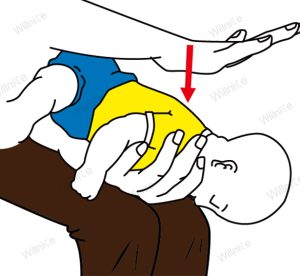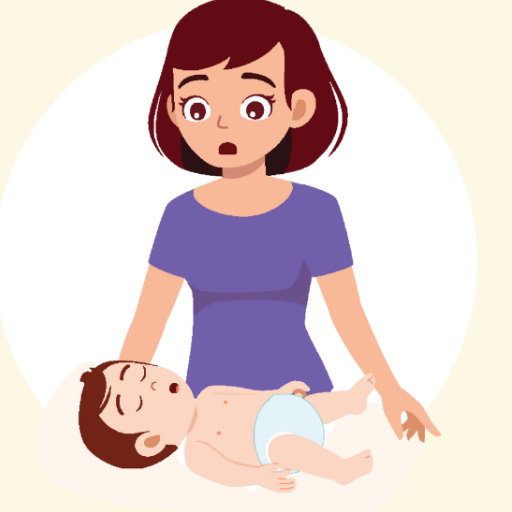
Being in a situation where a baby is choking is very cough-inducing and requires you to act without hesitation. Quick thinking matters the most if you do not wish to find yourself in the middle of a tragedy. This post is meant to help parents, caregivers, and everyone in charge of infants with simple yet effective first aid that can be lifesaving. In the course of this research, we are going to analyze the situation where one can tell that a person is choking, what the possible causes are, and how to help the infant’s choking with the aid of various techniques. It only takes one training for you to grab the opportunity and swoop in if there is a time sensitive instance like an infant choking but it can mean the world to a situation where a precious child’s life is at stake.
What are the Signs of Choking in a Baby?

Recognizing the signs of choking in a baby is critical for prompt intervention. The most common signs include difficulty breathing, visible distress, and an inability to cry or make sounds. A choking infant may have a bluish color to their skin, especially around the lips or face, indicating a lack of oxygen. They may also exhibit signs of gagging or coughing, although it's important to note that a weak or silent cough can signify severe airway obstruction. Observing these cues quickly and accurately is vital to addressing the situation and performing necessary first aid actions.
How to Recognize a Choking Baby
In my experience, recognizing a choking baby involves staying calm and observing key indicators. Changes in skin color, and an inability to cry as primary signs of choking. Additionally, a baby may look distressed, with possible gagging or weak coughing, signaling the airway is blocked. Watching for these signs helps me assess the severity of the situation promptly, which is critical for taking appropriate first aid measures.What to Do When a Baby is Choking
To begin with, check whether the baby is breathing, coughing or crying, or if not, if the skin around the mouth or face has a bluish color. Do not use your fingers to retrieve the object as this may worsen the situation. Instead, start by placing the child on their stomach, resting the child’s head on your forearm, and perform five gentle thrusts between the shoulder blades. If the baby is less than one year of age, perform the aforementioned action. After the five gentle thrusts, rotate the baby onto the back-side and press a finger in the middle of the baby’s chest (just below the nipple line) five times with a bit of force. After performing these steps, try the first two steps until the object has been removed. Always ensure to call 911 simultaneously if there is an emergency.
Understanding the Risk of Choking for Infants
Understanding the risk of choking for my infant involves knowing which foods and objects pose the greatest hazards. Small, hard foods like nuts, popcorn, and whole grapes are high-risk, as infants' airways are small and easily obstructed. Additionally, non-food items like small toys, coins, and batteries are common choking threats. To minimize risks, I cut foods into small pieces and always supervise my baby while eating or playing. It’s also beneficial to baby-proof the home by keeping hazardous items out of reach, and educating myself on first aid techniques, ensuring I’m prepared to act swiftly in an emergency.How to Perform First Aid When a Baby is Choking?

When performing first aid on a choking baby, it is crucial to remain calm and act quickly. First, assess the severity of the choking. If the baby can cough, cry, or make sounds, encourage them to do so as it may help dislodge the object. Do not insert fingers into the baby's mouth to remove the object, as this could push it further down the throat. If the baby is silent or unable to breathe, position them face-down on your forearm, supporting the head. Deliver up to five firm back blows using the heel of your hand between the shoulder blades. Next, turn the baby over and provide up to five chest thrusts with two fingers in the center of their chest, just below the nipple line. Alternate between back blows and chest thrusts until the object is expelled or emergency professionals arrive. If the infant becomes unresponsive, begin CPR immediately and call for help.
Steps for Choking First Aid
The very first thing one should remember while performing first aid on a choking infant is to analyze the situation fast. Always try to make sure why the child is unable to make any sounds or cough, whether it is because they are crying or because they are choking and cannot breathe. If their lungs have a wee bit of air, tell them to make a voluntary cough while watching what they do. A total blockage requires immediate action: In this case, the baby is turned on his stomach, resting on the forearm. Now the hand that was holding the arm rests over the shoulder blades, and several hits on the same spot are delivered. After this, chest compressions are given, the baby’s back is towards the hand, and two fingers are used to exert pressure on the baby’s sternum below the nipples. Alternate between the two to aim at separation of the obstruction.
How to Administer Back Blows and Chest Thrusts
To administer back blows and chest thrusts to a choking infant, act swiftly and calmly. First, confirm that the baby is truly choking, as evidenced by the inability to cough, cry, or breathe. For back blows, secure the baby by placing them face-down along your forearm with their head supported by your hand. Use the heel of your other hand to deliver firm yet gentle blows between the infant's shoulder blades. If this doesn't dislodge the object, proceed with chest thrusts by turning the baby face-up, supporting their back against your forearm, and using two fingers to compress the breastbone just below the nipple line with precise force. Alternate between five back blows and five chest thrusts until the obstruction is cleared or medical assistance takes over. If the infant becomes unresponsive, initiate CPR immediately and call for emergency aid while ensuring continuous care and observation even after the incident.
When to Call 911 in a Choking Emergency
If the infant is unable to breathe, cry, or cough and has lost consciousness, calling 911 is your best option. This is one of the numerous signs of the complete blockage of a person's airway, and in this case, quick treatment is essential. Give five back blows followed by five chest thrusts while you wait for emergency medical services to arrive. If while performing these measures the infant turns unresponsive, start the required CPR and direct someone towards making a call to call 911. Keep waiting for professional help to arrive while following the procedure that the emergency services provided over the phone.
What Should You Do if a Choking Infant Loses Consciousness?

If a choking infant loses consciousness, it's crucial to prioritize starting CPR right away. Ensure the infant is placed on a firm, flat surface, then begin performing chest compressions at a rate of 100 to 120 compressions per minute. Use two fingers to deliver compressions in the center of the infant’s chest, slightly below the nipple line. After every 30 compressions, provide two rescue breaths by sealing your mouth over the infant’s mouth and nose, ensuring you see the chest rise. Continue this cycle of compressions and breaths without interruption until emergency medical personnel arrive or the infant begins to breathe or respond on their own.
Performing Infant CPR
Performing infant CPR can be a daunting experience, but I now understand it's crucial to act swiftly and confidently. After placing the infant on a firm, flat surface, I need to start with chest compressions. Using two fingers, I should push down on the center of the infant's chest at a rate of 100 to 120 compressions per minute, just below the nipple line. It’s essential to stay focused on the rhythm and depth of each compression to effectively circulate the blood. After completing 30 compressions, I’ll give the infant two rescue breaths by covering their mouth and nose with mine, making sure their chest rises with each breath. This cycle needs to be repeated without interruption until the infant shows signs of recovery or medical help arrives.
How to Dislodge the Object Safely
When an infant is choking, it's essential to act quickly and carefully to dislodge the object. Begin by holding the infant face down on your forearm, supporting their head with your hand. Administer five firm back blows between the infant's shoulder blades using the heel of your hand. If these back blows don't clear the obstruction, turn the infant over while supporting their head and perform five chest thrusts. Thrusts are done by placing two fingers at the center of the chest, slightly below the nipple line, and pushing downward sharply but gently. Continue to alternate between five back blows and five chest thrusts, checking after each cycle to see if the object has been expelled. This procedure should be repeated until the airway is clear or professional medical help arrives.
Common Choking Hazards for Babies

Babies explore their surroundings using their mouths, making them susceptible to choking hazards. Common choking risks include small food items such as nuts, grapes, and popcorn, as well as round, firm foods like raw carrots and hot dog slices which can easily obstruct an airway. Non-food items also pose significant threats; small toys, buttons, coins, and batteries are frequent culprits. Parents and caregivers should always supervise babies during meal times and ensure that non-food items are kept out of reach. Adopting preventative measures, such as cutting foods into small, manageable pieces and keeping the environment free from potential hazards, can significantly reduce the risk of choking.
Identifying Choking Hazards in the Home
When it comes to identifying choking hazards in the home, I've learned that vigilance is key. I've ensured that I routinely scan my living space for any small items that could be within reach of a curious baby. This includes regularly checking the floors and low surfaces for coins, beads, or small toy parts. I've also made sure to secure meals by cutting foods into small, manageable pieces and steering clear of potential choking culprits like nuts, grapes, and popcorn. Another step I've taken is to store non-food items like batteries, buttons, and plastic bags well out of reach. Creating a safe environment for my baby has required a balance of preventive actions and constant awareness.
Preventing Choking with Solid Foods
To effectively prevent choking when introducing solid foods to babies, there are several key strategies to follow. First, ensure that all solid foods are cut into pieces no larger than half an inch to prevent blockage in a baby's airway. Additionally, consider cooking or steaming hard vegetables like carrots to soften them, making them easier to chew and swallow. Offer foods that easily dissolve in the mouth, such as puffed cereals and ripe bananas. Supervise meal times closely to quickly address any signs of distress, such as gagging or coughing. Avoid high-risk foods, including whole nuts, raw fruits and vegetables, and sticky foods like peanut butter.
Creating a Safe Environment for Infants
What are the Steps to Take if a Baby is Gagging?

If a baby is gagging, it is important to remain calm and carefully monitor the situation. First, observe if the baby is able to clear the obstruction by coughing, as this is often the most effective method for them to resolve the issue on their own. Ensure the baby is sitting upright to facilitate airway clearance. If the baby shows any signs of distress, like turning blue or having difficulty breathing, quickly assess if any visible object can be safely removed from their mouth. Avoid blindly sweeping the mouth with your fingers, as this could push the object further down. If the baby continues to struggle or becomes unresponsive, call emergency services immediately and begin CPR if trained to do so. Always seek medical attention afterward, even if the obstruction seems resolved, to ensure no internal damage has occurred.
Understanding the Difference Between Gagging and Choking
Understanding the difference between gagging and choking is crucial for ensuring the safety and well-being of infants and children. Gagging is a common and typically less serious reflex that helps a person clear their throat of unwanted items and is often characterized by coughing and noisy breathing. It serves as a protective mechanism to prevent choking by pushing foreign objects from the mouth before they reach the airway. In contrast, choking occurs when an object becomes lodged in the throat or windpipe, blocking airflow entirely and making it a medical emergency. During choking, there is usually an absence of sound or breathing, and the affected individual may appear panicked or silent due to the blocked airway. Rapid intervention is necessary in choking incidents, such as administering back blows or chest thrusts. Recognizing these key differences empowers caregivers to respond effectively, ensuring they can distinguish between a benign gagging incident and a potentially life-threatening choking episode.
How to Respond to a Gagging Baby
When responding to a gagging baby, it is important to remain calm and allow them to resolve it on their own, as gagging often helps expel the object naturally. Refrain from inserting fingers or objects into their mouth, as this might induce choking. Encourage the baby to continue coughing, as this reflex usually clears the airway. Observe their behavior and breathing carefully; if they appear red-faced but continue to make noise or cough, it is a sign that they can still receive some air. However, if the baby's gagging escalates to choking, immediate action is necessary. Remember, gagging is a protective mechanism and typically less serious, but always be attentive to any changes in their condition.
When Help Arrives: What to Do Next
When professional help arrives, it is essential to promptly convey critical information about the situation. Ensure that you provide a clear recount of the events leading to the emergency, detailing how long the baby has been in distress and any first aid measures that were attempted. Keep a calm demeanor to facilitate effective communication with responders, which can be crucial in guiding their intervention. If the gagging episode transitions into choking, it's important to inform the responders about any visible signs, such as changes in the baby's color, breathing patterns, or consciousness. The professional team will take over and conduct necessary medical evaluations to assess the baby's airway and overall condition. Remain on hand to offer assistance as needed and follow their directives, ensuring that the baby's needs are met swiftly and safely.
References
Choking Cardiopulmonary resuscitation First aidFrequently Asked Questions (FAQ)
Q: What are the signs that a baby is choking?
A: Signs that a baby is choking include difficulty breathing, coughing forcefully, a high-pitched noise when breathing, or the inability to cry or make much sound. If the infant is coughing forcefully, they may be trying to dislodge the object themselves.Q: What should I do if my baby is choking?
A: If your baby is choking and cannot cough forcefully, it’s important to keep calm and follow these steps: Place the baby face down over your thigh, supporting the infant's chest in your hand. Give up to 5 back blows with the heel of your free hand. If the object does not dislodge, turn the baby over and give 5 chest thrusts using two fingers in the center of the infant's chest.Q: When should I call for emergency help if a baby is choking?
A: You should call for emergency help immediately if the baby becomes unconscious, cannot breathe at all, or if the object does not come out after you have performed back blows and chest thrusts. Start baby CPR if the child becomes unconscious.Q: Why is the heel of the free hand used during back blows?
A: The heel of your free hand is used during back blows because it provides a firm and controlled force to help dislodge the object blocking the airway. This is part of the basic life support steps to help save lives.Q: Can toys with small parts increase the risk for choking in infants?
A: Yes, toys with small parts can increase the risk for choking in infants. It is crucial to ensure that toys are appropriate for the baby’s age and do not have detachable small parts that could become lodged in the throat.Q: Is it safe to give abdominal thrusts to a choking infant?
A: No, abdominal thrusts are not recommended for infants. The correct procedure for a baby is to use back blows and chest thrusts. Abdominal thrusts are generally used for older children and adults.Q: What should I do if the piece of food is still stuck after performing first aid?
A: If the piece of food or object is still stuck after performing 5 back blows and 5 chest thrusts, continue alternating between these techniques until emergency help arrives. If the infant loses consciousness, begin CPR immediately.Q: How can I prevent choking in my baby?
A: To prevent choking, supervise your baby during meals and avoid giving them small, hard foods. Cut food into small, manageable pieces, and be cautious with foods like nuts, popcorn, and grapes. Avoid toys with small parts and ensure the baby’s environment is free from small objects they could put in their mouth.Q: Are there any reliable resources for learning more about choking first aid for infants?
A: Yes, the MedlinePlus Medical Encyclopedia and other gov website resources provide detailed and reliable information on choking in infants and basic life support techniques to help save lives. They are excellent resources for learning more about how to handle a choking baby.







 Login with Google
Login with Google Login with Facebook
Login with Facebook